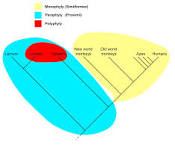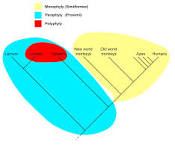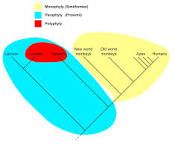![]()
![]()
![]()
Use LEFT and RIGHT arrow keys to navigate between flashcards;
Use UP and DOWN arrow keys to flip the card;
H to show hint;
A reads text to speech;
63 Cards in this Set
- Front
- Back
|
parallel evolution |
-When two species are similar in a particular character, evolution is defined as parallel if the ancestors shared that similarity; if they did not, the evolution of that character in those species is defined as convergent. -When a character is passed from parent to offspring without any change |
|
|
retroposition |
In genetics, the integration of a sequence derived from RNA into a DNA genome. Messenger RNA (mRNA) is reverse-transcribed and reintegrated into the genome. Retroposition is an important mechanism of gene copying. It produces a large number of functional genes in the genome and accounts for about 10,000 duplications in the human genome. |
|
|
hox genes |
Hox genes (also known as homeotic genes) are a group of related genes that control the body plan of an embryo along the anterior-posterior (head-tail) axis. After the embryonic segments have formed, the Hox proteins determine the type of segment structures (e.g. legs, antennae, and wings in fruit flies or the different types of vertebrae in humans) that will form on a given segment. Hox proteins thus confer segmental identity, but do not form the actual segments themselves |
|
|
inversion |
Breaks in DNA are repaired by proteins thatrejoin broken ends: opportunity for joining wrong endsResults in multiple alleles being genetically linkedRecombination with in inverted region is very rareIn heterozygote for inversion, region does not align |
|
|
convergent evolution |
In evolutionary biology, convergent evolution is the process whereby organisms not closely related (not monophyletic), independently evolve similar traits as a result of having to adapt to similar environments or ecological niches. |
|
|
insertion mutation |
chunk of DNA is inserted in current sequence, causes frameshift |
|
|
RNASE1B |
related to monkey example |
|
|
RNASE1 |
related to monkey example |
|
|
LINE |
Long interspersed element, group of genetic elements that are found in large numbers in eukaryotic genomes |
|
|
homoplasy |
A homoplasy is a character shared by a set of species but not present in their common ancestor. A good example is the evolution of the eye which has originated independently in many different species. When this happens it is sometimes called a convergence. |
|
|
codon redundancy |
64 options for codons but only 20 amino acids so some of the code is redundant |
|
|
intron |
part of sequence in eukaryotes that does not get interpreted into
|
|
|
duplication |
error in dna replication where the dna is duplicated and reinserted |
|
|
nonsynonymous base substitution |
A nonsynonymous substitution is a nucleotide mutation that alters the amino acid sequence of a protein. It is contrasted with synonymous substitutions which do not alter amino acid sequences. As nonsynonymous substitutions result in a biological change in the organism, they are subject to natural selection. |
|
|
orthologs
|
homologous genes that are the result of a speciation event |
|
|
beneficial mutations |
beneficial mutation |
|
|
deletion |
section of dna is deleted |
|
|
frameshift |
reading frame is altered |
|
|
mutagenesis |
genetic material of the organism is changed in a stable manner, either spontaneously or by a mutagen |
|
|
mutation accumulation experiment |
part of the do mutations reduce fitness part. randomly picking offspring and measuring the fitness of their inherited mutations |
|
|
Heliconius |
species of butterfly that has two different types of wing colors and are unable to hybridize |
|
|
co-mimics |
from butterfly example, species that share the same traits but are not sister species
|
|
|
optix gene |
transcription factor that regulates wing color in butterflies
|
|
|
ancestral alleles |
alleles carried by the taxon that the organism is classified in |
|
|
spatial colinearity |
distribution of hox genes in eukaryotic genome |
|
|
canonical spatial expression pattern |
refers to where the gene is expressed |
|
|
environmental variation |
the diversity in a population that is due to the environment. split into direct and indirect(daphnia and thorns on head) |
|
|
genetic variation |
variation due to genetic factors |
|
|
reaction norm |
range of phenotypesa genotype expresses across different environments |
|
|
hornworm caterpillar |
turn black if hit by heatshock before molting |
|
|
rearrangement |
rearrangement |
|
|
leopard gecko |
temperature of developing eggs can determine individual’s sexTiming of expression of Sox9: continued expression commits the gonad to being a testisIs there variation in the developmental switch in response to temperature? |
|
|
male sex ratio |
much higher when in the right temperature (70% at 30.5-32.5 degrees) |
|
|
artiodactyl |
even toed ungulate |
|
|
|
|
|
|
phenotypic plasticity |
the ability of an organism to change its phenotype based on environmental variables |
|
|
phylogenetic tree |
represent the inferred evolutionary history: • shows the origins of lineages (when a population split; branch points) • shows the origins of innovations (derived trait)• shows the timing of origins • shows the relative 'genetic relatedness' of species/taxa |
|
|
synapomorphy |
In cladistics, a synapomorphy or synapomorphic character state is a trait that is shared ("symmorphy") by two or more taxa and inferred to have been present in their most recent common ancestor, whose own ancestor in turn is inferred to not possess the trait. |
|
|
polyphyletic group |

|
|
|
parsimony |
Parsimony analysis states that the tree with the fewest evolutionary changes is the most probable; simplest explanation is best.For each possible tree, a scenario is ‘mapped’ for each informative character |
|
|
uninformative characters |
uninformative sites don't give information about evolutionary relationships among taxa |
|
|
neighbour joining |
using a distance matrix to determine what the phylogenetic tree looks like |
|
|
|
|
|
|
|
|
|
|
4 assumptions for an ideal tree |
1) Ancestral characters are known 2) Each derived character evolves only once 3) No other lineage/species has the derived character 4) Once evolved, a derived character is never lost |
|
|
|
|
|
|
monophyletic |

|
|
|
paraphyletic
|

|
|
|
likelihood analysis |
another method of statistically testing phylogenetic trees compares to a model |
|
|
bayesian inference |
Bayesian inference derives the posterior probability as a consequence of two antecedents, a prior probability and a "likelihood function" derived from a statistical model for the observed data. Bayesian inference computes the posterior probability according to Bayes' theorem |
|
|
bootstrapping |
• Random sampling of original data • Create large number of bootstrap datasets • Analyze bootstrap datasets individually by parsimony analysis • In what percentage of analyses is a group supported? ~ >70% is good support |
|
|
SINE |
Short interspersed nuclear elements, short dna sequences <500 bases that represent reverse transcribed RNA molecules originally transcribed by RNA polymerase |
|
|
levels of biological organization |
Atoms(bonds and chemistry) marcomolecules(proteins, dna) -mechanisms for cell behavior -growth, metabolism, divide, signaling, differentiate, die cells tissues organ systems individual phenotype -mechanisms -selection, mutation, others -contribution to gene pool conditions of life |
|
|
human taste receptor |
TAS2Rs, two alleles: AVI/PAV
|
|
|
genotype-by-environment variation |
lizards and caterpillars |
|
|
rates of dna mutation |
-high fidelity polymerase: 10^-7 with proofreading, after mismatch repair ~10^-9
-low fidelity polymerase: 10^-1 to 10^-2 |
|
|
paralogs |
created by duplication event within the genome |
|
|
homeotic genes |
Homeotic genes are genes which regulate the development of anatomical structures in various organisms such as insects, mammals, and plants. |
|
|
somite formation |
A somite is a division of the body of an animal or embryo.Somites are bilaterally paired blocks of paraxial mesoderm that form along the head to tail axis of the developing embryo in segmented animals. In vertebrates, somites give rise to the vertebrae of the spine, rib cage, (and part of the occipital bone); skeletal muscle, cartilage, tendons, and skin. |
|
|
morphogen gradients |
mechanism: 'organizing center' synthesizes morphogen; distribution then creates position specific signals output: position specific cell behavior such as dividing, differentiating, maturing |
|
|
developmental constrait |
A lineage’s development may limit the sorts of phenotypes that it can evolve. This limitation is called a developmental constraint.
|
|
|
retrotransposon |
Retrotransposons are transposable DNA elements (transposons) that employ retroviral-like reverse transcription during the process of transposition: retrotransposon DNA is first transcribed into an RNA template, then reverse transcribed into DNA, and then inserted into a new genomic site.
|
|
|
parthenogenesis |
Parthenogenesis is a form of asexual reproduction in which growth and development of embryos occur without fertilization. In animals, parthenogenesis means development of an embryo from an unfertilized egg cell and is a component process of apomixis.
|

